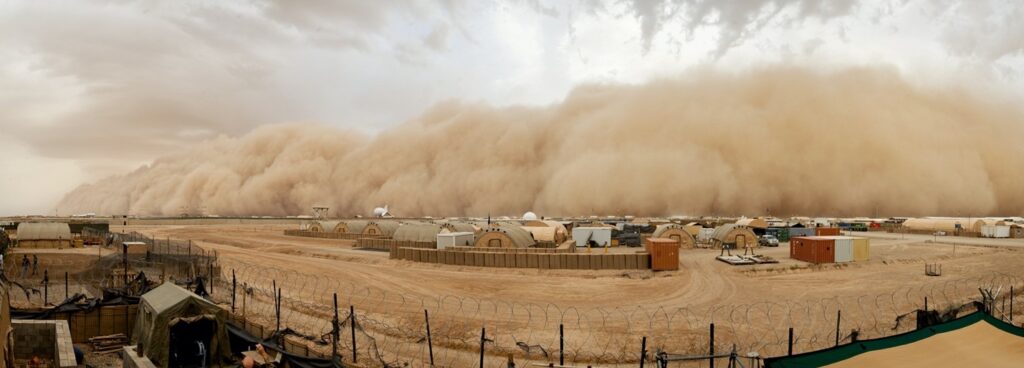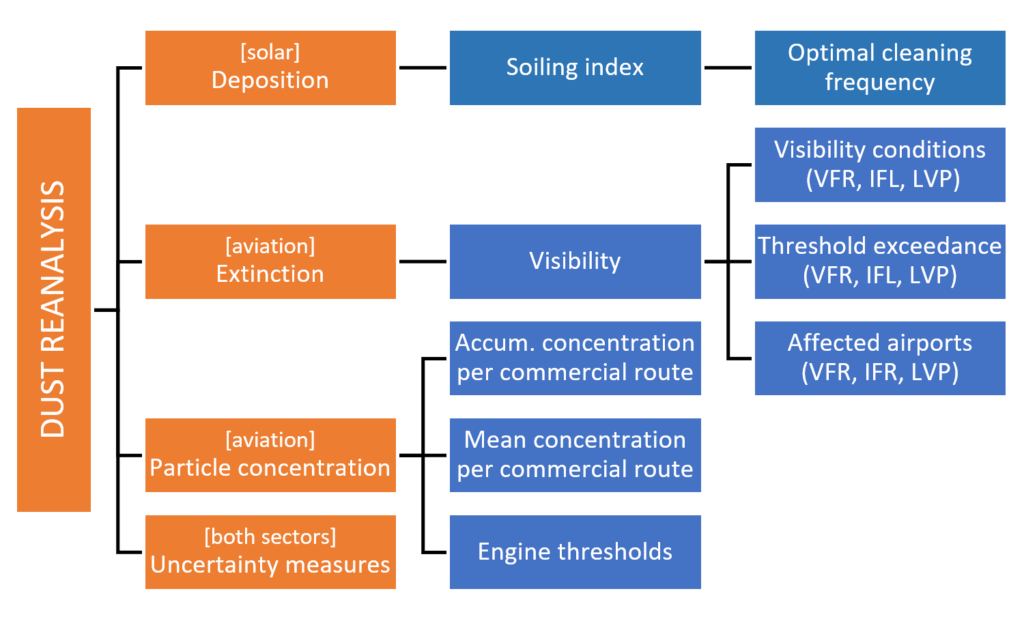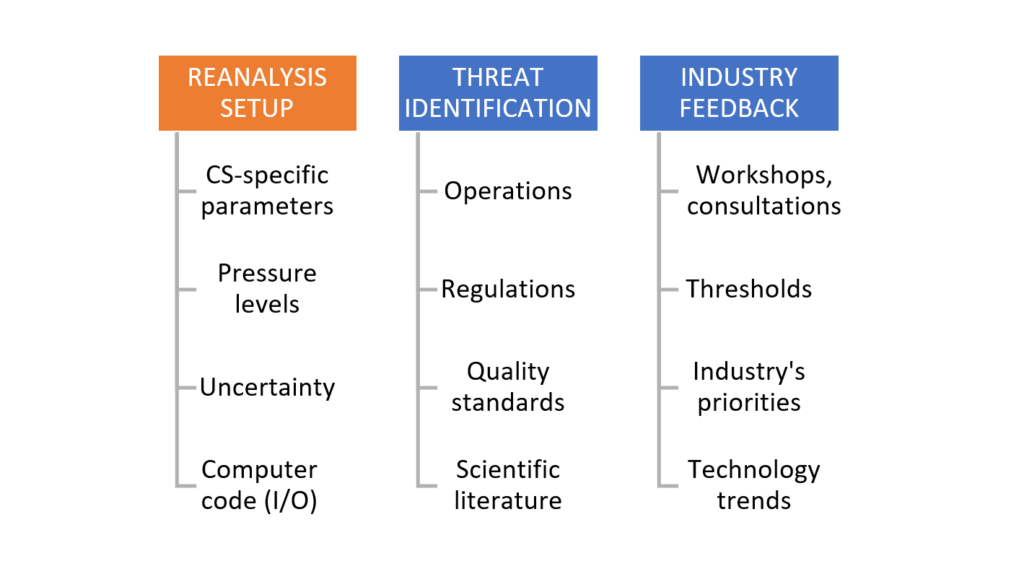Sand and dust storms (SDS) entail short- and long-term operational threats for aviation and solar energy production. The ERA4CS DustClim project is assisting these sectors in understanding and reducing SDS-related risks, by producing a state-of-the-art reanalysis climatology and a set of specialized impact analysis products with industry partners.
ATHANASIOS VOTSIS1, FRANCESCA BARNABA2, SARA BASART3, ENZA DI TOMASO3, PAOLA FORMENTI4, ANDERS LINDFORS1, LUCIA MONA5, TUUKKA RAUTIO1, YIJUN WANG1, ERNEST WERNER HIDALGO6
1Finnish Meteorological Institute (FMI), Finland
2Consiglio Nazionale delle Ricerche-Istituto di Scienze dell’Atmosfera e del Clima (CNR-ISAC), Italy
3Barcelona Supercomputing Center (BSC), Spain
4LISA, UMR CNRS 7583, Université Paris-Est-Créteil, Université de Paris, Institut Pierre Simon Laplace (IPSL), Créteil, France
5Consiglio Nazionale delle Ricerche-Istituto di Metodologie per l’Analisi Ambientale (CNR-IMAA), Italy
6State Meteorological Agency (AEMET), Spain
Sand and dust storms (SDS) are an important threat to health, property, equipment, and the economy in many countries, whereas the scales of the threat can be considerable (Fig. 1). In many cases, the risks include loss of lives, substantial disruptions of activities and operations, and economic losses. Some of the risks are expected to increase due to a combination of climatic, social, and technological trends. DustClim (Dust Storms Assessment for the development of user-oriented Climate Services in Northern Africa, Middle East and Europe) aims to provide reliable information on SDS for developing dust-related services for the air quality, aviation and solar energy sectors. In this paper, we present our approach to developing purpose-specific products that help the aviation and solar energy production industry in understanding and reducing SDS-related risks. We finish with a brief overview of the products.

DustClim is producing a state-of-the-art dust reanalysis over the domain of Northern Africa, the Middle East, and Europe at an unprecedented high spatial resolution (10km x 10km) using the state-of-art NMMB-MONARCH model and its advanced data assimilation capabilities (Di Tomaso et al. 2017) as well as quality dust satellite products and their respective uncertainties.
The resulting reanalysis is at present the most advanced basis to understand the long-term risks of operating in risky sand and dust environments. To exploit this potential in a way that better covers the needs of aviation operations and solar energy production, we identified SDS-related ‘objective threats’ by referring to operational manuals, regulations and standards, scientific literature, and other technical documentation, the results of which have been in a continuous interplay with the development of the SDS reanalysis climatology, including the evaluation of uncertainty. This allowed to give the necessary focus to both the envisioned products and reanalysis setup. Next, we initiated an ongoing dialogue with industry partners, aiming to expose our product concepts to flexible, expert peer-review, and potential co-refinements of the products. Our development methodology (Fig. 2 top) has ensured that the products are (a) grounded in state-of-the-art science, (b) are motivated by risks encountered by operations and regulatory standards, and (c) are critically modified into case-relevant knowledge for end-users. Fig. 2 (bottom) summarizes the first round of products.

SDS affect aviation operations mainly through reduced visibility and mechanical effects. Reduced visibility affects mainly navigation and approach/landing/take-off, route planning, and ground support operations. Mechanical effects include the scouring, corrosion, erosion, or abrasion of aircraft surfaces, instrumentation, and engines and have implications for safety, certification standards, and maintenance schedules and costs (Baddock et al. 2013; Clarkson and Simpson 2017). We address visibility effects through products that indicate (a) exceedances of instrument flight rules, visual flight rules, and low-visibility procedures thresholds for 14 flight levels and various temporal aggregations and (b) implications for airport closures according to their current instrument approach capacity. We address mechanical effects by providing measures of the accumulated exposure of aircraft and engine to particle concentrations for approx. 70000 flight routes and 14 flight levels, which is primarily related to engine abrasion.
In solar energy production, SDS reduce the capacity of solar panels to produce energy through two main channels: by reducing the incoming solar irradiance directly (through absorption and scattering) or indirectly (through dust-induced cloud formation and/or cloud modification) and by depositing material on the solar panel. Deposition affects all three main solar energy technologies: photovoltaics (PV), concentrating solar power (CSP), and concentrating photovoltaics (CPV). Dust deposited on transparent or glass materials decreases transmissivity capacity, whereas dust deposited on mirror materials decreases reflectance (Sarver et al. 2013; Mejia et al 2013). These effects relate to simple blockage of the incoming irradiance, but also to chemical interaction with the panel’s surface material, which, in addition to blockage, has corrosive effects (Sarver et al. 2013). We focus on deposition effects on solar PV panels, providing products that (a) indicate dry and wet deposition on panel surface, (b) subsequent energy output reduction communicated as a soiling index, (c) optimal cleaning frequency for operating with profit, and (d) investment risk per location.
Acknowledgements: DustClim is supported by the European Commission under the ERA4CS action – Joint Call on Researching and Advancing Climate Services Development, Grant Agreement no. 690462 – ERA4CS – H2020-SC5-2014-2015/H2020-SC5-2015-one-stage. Dr Paul Ginoux and Dr Antonis Gkikas are gratefully acknowledged for their collaboration in the development of the project. The World Meteorological Organization (WMO) Sand and Dust Storm Warning Advisory and Assessment System (SDS-WAS) Regional Center for Northern Africa, the Middle East and Europe as well as the EU COST Action inDust (CA16202) are also acknowledged for providing indispensable support to the user interaction activities.
References
Baddock, M. C., et al., 2013: Aeolian dust as a transport hazard, Atmos. Environ., 71, 7–14. DOI: https://doi.org/10.1016/j.atmosenv.2013.01.042
Clarkson, R., and Simpson, H., 2017: Maximising Airspace Use During Volcanic Eruptions: Matching Engine Durability against Ash Cloud Occurrence, NATO STO AVT-272 Specialists Meeting on ”Impact of Volcanic Ash Clouds on Military Operations” Volume: 1.
Di Tomaso, E., et al., 2017: Assimilation of MODIS Dark Target and Deep Blue observations in the dust aerosol component of NMMB-MONARCH version 1.0, Geosci. Model Dev., 10, 1107–1129, DOI: https://doi.org/10.5194/gmd-10-1107-2017
Mejia, F., et al., 2013: The effect of dust on solar photovoltaic systems, Energy Procedia, 49, 2370–2376. DOI: https://doi.org/10.1016/j.egypro.2014.03.251
Sarver, T., et al., 2013: A Comprehensive Review of the Impact of Dust on the Use of Solar Energy: History, Investigations, Results, Literature, and Mitigation Approaches, Renew. Sust. Energ. Rev., 22, 698–733, DOI: https://doi.org/10.1016/j.rser.2012.12.065
HOW TO CITE THIS ARTICLE:
Votsis A., Barnaba F., Basart S., Di Tomaso E., Formenti P., Lindfors A., Mona L., Rautio T., Wang Y, and Hidalgo E. W., 2020: Operational risks of sand and dust storms in aviation and solar energy: the DustClim approach, FMI’s Climate Bulletin: Research Letters, 2(1), 6–7, DOI: https://doi.org/10.35614/ISSN-2341-6408-IK-2020-02-RL
CITATION INFORMATION:
Authors: Athanasios Votsis, Francesca Barnaba, Sara Basart, Enza Di Tomaso, Paola Formenti, Anders Lindfors, Lucia Mona, Tuukka Rautio, Yijun Wang, and Ernest Werner Hidalgo
Received: March 3, 2020
Accepted: April 30, 2020
First online: May 20, 2020
Published: May 25, 2020
Journal: FMI’s Climate Bulletin: Research Letters
Volume: 2
Issue: 1
Pages: 6–7
DOI: https://doi.org/10.35614/ISSN-2341-6408-IK-2020-02-RL
This article is part of the ERA4CS Special Issue.
Header image: Cpl Daniel Wiepen




